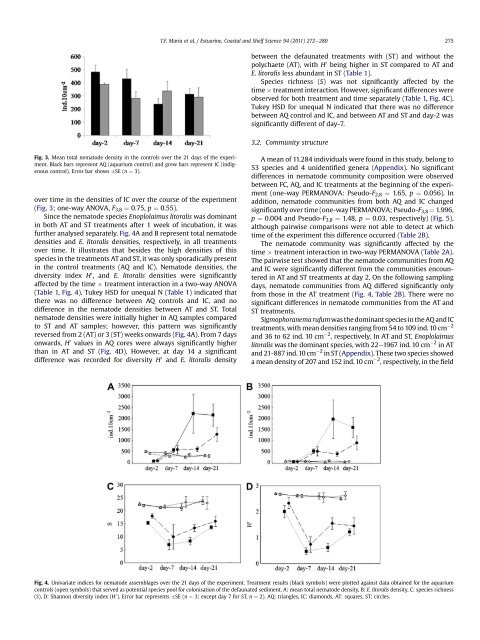The effect of the dominant polychaete Scolelepis squamata on ...
The effect of the dominant polychaete Scolelepis squamata on ...
The effect of the dominant polychaete Scolelepis squamata on ...
You also want an ePaper? Increase the reach of your titles
YUMPU automatically turns print PDFs into web optimized ePapers that Google loves.
Fig. 3. Mean total nematode density in <str<strong>on</strong>g>the</str<strong>on</strong>g> c<strong>on</strong>trols over <str<strong>on</strong>g>the</str<strong>on</strong>g> 21 days <str<strong>on</strong>g>of</str<strong>on</strong>g> <str<strong>on</strong>g>the</str<strong>on</strong>g> experiment.<br />
Black bars represent AQ (aquarium c<strong>on</strong>trol) and grew bars represent IC (indigenous<br />
c<strong>on</strong>trol). Error bar shows SE (n ¼ 3).<br />
over time in <str<strong>on</strong>g>the</str<strong>on</strong>g> densities <str<strong>on</strong>g>of</str<strong>on</strong>g> IC over <str<strong>on</strong>g>the</str<strong>on</strong>g> course <str<strong>on</strong>g>of</str<strong>on</strong>g> <str<strong>on</strong>g>the</str<strong>on</strong>g> experiment<br />
(Fig. 3; <strong>on</strong>e-way ANOVA, F3,8 ¼ 0.75, p ¼ 0.55).<br />
Since <str<strong>on</strong>g>the</str<strong>on</strong>g> nematode species Enoplolaimus litoralis was <str<strong>on</strong>g>dominant</str<strong>on</strong>g><br />
in both AT and ST treatments after 1 week <str<strong>on</strong>g>of</str<strong>on</strong>g> incubati<strong>on</strong>, it was<br />
fur<str<strong>on</strong>g>the</str<strong>on</strong>g>r analysed separately. Fig. 4A and B represent total nematode<br />
densities and E. litoralis densities, respectively, in all treatments<br />
over time. It illustrates that besides <str<strong>on</strong>g>the</str<strong>on</strong>g> high densities <str<strong>on</strong>g>of</str<strong>on</strong>g> this<br />
species in <str<strong>on</strong>g>the</str<strong>on</strong>g> treatments AT and ST, it was <strong>on</strong>ly sporadically present<br />
in <str<strong>on</strong>g>the</str<strong>on</strong>g> c<strong>on</strong>trol treatments (AQ and IC). Nematode densities, <str<strong>on</strong>g>the</str<strong>on</strong>g><br />
diversity index H 0 , and E. litoralis densities were significantly<br />
affected by <str<strong>on</strong>g>the</str<strong>on</strong>g> time treatment interacti<strong>on</strong> in a two-way ANOVA<br />
(Table 1, Fig. 4). Tukey HSD for unequal N (Table 1) indicated that<br />
<str<strong>on</strong>g>the</str<strong>on</strong>g>re was no difference between AQ c<strong>on</strong>trols and IC, and no<br />
difference in <str<strong>on</strong>g>the</str<strong>on</strong>g> nematode densities between AT and ST. Total<br />
nematode densities were initially higher in AQ samples compared<br />
to ST and AT samples; however, this pattern was significantly<br />
reversed from 2 (AT) or 3 (ST) weeks <strong>on</strong>wards (Fig. 4A). From 7 days<br />
<strong>on</strong>wards, H 0 values in AQ cores were always significantly higher<br />
than in AT and ST (Fig. 4D). However, at day 14 a significant<br />
difference was recorded for diversity H 0 and E. litoralis density<br />
T.F. Maria et al. / Estuarine, Coastal and Shelf Science 94 (2011) 272e280 275<br />
between <str<strong>on</strong>g>the</str<strong>on</strong>g> defaunated treatments with (ST) and without <str<strong>on</strong>g>the</str<strong>on</strong>g><br />
<str<strong>on</strong>g>polychaete</str<strong>on</strong>g> (AT), with H 0 being higher in ST compared to AT and<br />
E. litoralis less abundant in ST (Table 1).<br />
Species richness (S) was not significantly affected by <str<strong>on</strong>g>the</str<strong>on</strong>g><br />
time treatment interacti<strong>on</strong>. However, significant differences were<br />
observed for both treatment and time separately (Table 1, Fig. 4C).<br />
Tukey HSD for unequal N indicated that <str<strong>on</strong>g>the</str<strong>on</strong>g>re was no difference<br />
between AQ c<strong>on</strong>trol and IC, and between AT and ST and day-2 was<br />
significantly different <str<strong>on</strong>g>of</str<strong>on</strong>g> day-7.<br />
3.2. Community structure<br />
A mean <str<strong>on</strong>g>of</str<strong>on</strong>g> 11.284 individuals were found in this study, bel<strong>on</strong>g to<br />
53 species and 4 unidentified genera (Appendix). No significant<br />
differences in nematode community compositi<strong>on</strong> were observed<br />
between FC, AQ, and IC treatments at <str<strong>on</strong>g>the</str<strong>on</strong>g> beginning <str<strong>on</strong>g>of</str<strong>on</strong>g> <str<strong>on</strong>g>the</str<strong>on</strong>g> experiment<br />
(<strong>on</strong>e-way PERMANOVA: Pseudo-F2,8 ¼ 1.65, p ¼ 0.056). In<br />
additi<strong>on</strong>, nematode communities from both AQ and IC changed<br />
significantly over time (<strong>on</strong>e-way PERMANOVA; Pseudo-F3,8 ¼ 1.996,<br />
p ¼ 0.004 and Pseudo-F3,8 ¼ 1.48, p ¼ 0.03, respectively) (Fig. 5),<br />
although pairwise comparis<strong>on</strong>s were not able to detect at which<br />
time <str<strong>on</strong>g>of</str<strong>on</strong>g> <str<strong>on</strong>g>the</str<strong>on</strong>g> experiment this difference occurred (Table 2B).<br />
<str<strong>on</strong>g>The</str<strong>on</strong>g> nematode community was significantly affected by <str<strong>on</strong>g>the</str<strong>on</strong>g><br />
time treatment interacti<strong>on</strong> in two-way PERMANOVA (Table 2A).<br />
<str<strong>on</strong>g>The</str<strong>on</strong>g> pairwise test showed that <str<strong>on</strong>g>the</str<strong>on</strong>g> nematode communities from AQ<br />
and IC were significantly different from <str<strong>on</strong>g>the</str<strong>on</strong>g> communities encountered<br />
in AT and ST treatments at day 2. On <str<strong>on</strong>g>the</str<strong>on</strong>g> following sampling<br />
days, nematode communities from AQ differed significantly <strong>on</strong>ly<br />
from those in <str<strong>on</strong>g>the</str<strong>on</strong>g> AT treatment (Fig. 4, Table 2B). <str<strong>on</strong>g>The</str<strong>on</strong>g>re were no<br />
significant differences in nematode communities from <str<strong>on</strong>g>the</str<strong>on</strong>g> AT and<br />
ST treatments.<br />
Sigmophoranema rufumwas <str<strong>on</strong>g>the</str<strong>on</strong>g> <str<strong>on</strong>g>dominant</str<strong>on</strong>g> species in <str<strong>on</strong>g>the</str<strong>on</strong>g> AQ and IC<br />
treatments, with mean densities ranging from 54 to 109 ind.10 cm 2<br />
and 36 to 62 ind. 10 cm 2 , respectively. In AT and ST, Enoplolaimus<br />
litoralis was <str<strong>on</strong>g>the</str<strong>on</strong>g> <str<strong>on</strong>g>dominant</str<strong>on</strong>g> species, with 22e1967 ind. 10 cm 2 in AT<br />
and 21-887 ind.10 cm 2 in ST (Appendix). <str<strong>on</strong>g>The</str<strong>on</strong>g>se two species showed<br />
a mean density <str<strong>on</strong>g>of</str<strong>on</strong>g> 207 and 152 ind. 10 cm 2 , respectively, in <str<strong>on</strong>g>the</str<strong>on</strong>g> field<br />
Fig. 4. Univariate indices for nematode assemblages over <str<strong>on</strong>g>the</str<strong>on</strong>g> 21 days <str<strong>on</strong>g>of</str<strong>on</strong>g> <str<strong>on</strong>g>the</str<strong>on</strong>g> experiment. Treatment results (black symbols) were plotted against data obtained for <str<strong>on</strong>g>the</str<strong>on</strong>g> aquarium<br />
c<strong>on</strong>trols (open symbols) that served as potential species pool for col<strong>on</strong>isati<strong>on</strong> <str<strong>on</strong>g>of</str<strong>on</strong>g> <str<strong>on</strong>g>the</str<strong>on</strong>g> defaunated sediment. A: mean total nematode density, B: E. litoralis density, C: species richness<br />
(S), D: Shann<strong>on</strong> diversity index (H 0 ). Error bar represents SE (n ¼ 3; except day 7 for ST, n ¼ 2). AQ: triangles, IC: diam<strong>on</strong>ds, AT: squares, ST: circles.

















